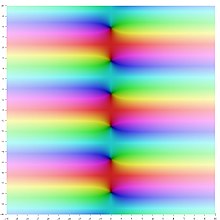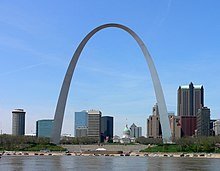在数学 中,双曲馀弦 是一种双曲函数 ,是双曲几何 中,与欧几里得几何的馀弦函数 相对应的函数。双曲馀弦一般以cosh表示[ 1]
C
o
s
{\displaystyle {\mathfrak {Cos}}}
[ 2] 悬链线 ,即两端固定自然下垂的绳索,因此可以用于进行悬索桥 的工程计算。
双曲馀弦一般记为
cosh
{\displaystyle \cosh }
[ 3]
ch
{\displaystyle \operatorname {ch} }
[ 4] 复分析 中定义为:
cosh
:
C
→
C
z
↦
e
z
+
e
−
z
2
{\displaystyle {\begin{matrix}\cosh :&\mathbb {C} &\to &\mathbb {C} \\&z&\mapsto &\displaystyle {\frac {e^{z}+e^{-z}}{2}}\end{matrix}}}
其中
z
↦
e
z
{\displaystyle z\mapsto e^{z}}
复变指数函数
复数域双曲馀弦的色相环复变函数图形 绿色线为双曲馀弦函数、蓝色线为自然指数函数、橙色线为
自然指数函数 的倒数。可以看到双曲馀弦函数为自然指数函数与其倒数的
平均数 也就是说,双曲馀弦可以视为指数函数 与其倒数 的算术平均数 [ 5] 自然指数函数 的偶函数部分 [ 6]
在双曲几何中,双曲馀弦函数类似于欧几里得几何中的馀弦 函数。一般的馀弦可以表示为单位圆上特定角的终边正向与圆之交点的x座标;而双曲馀弦则代表单位双曲线上特定双曲角的终边正向与单位双曲线之交点的x座标[ 7]
x
2
a
2
−
y
2
b
2
=
1
{\displaystyle {\frac {x^{2}}{a^{2}}}-{\frac {y^{2}}{b^{2}}}=1}
令
P
{\displaystyle P}
P
′
{\displaystyle P'}
P
{\displaystyle P}
y
2
b
2
−
x
2
a
2
=
1
{\displaystyle {\frac {y^{2}}{b^{2}}}-{\frac {x^{2}}{a^{2}}}=1}
P
=
(
x
P
,
y
P
)
{\displaystyle P=\left(x_{P},\,y_{P}\right)}
P
′
=
(
a
y
P
b
,
b
x
P
a
)
{\displaystyle P'=\left({\frac {ay_{P}}{b}},\,{\frac {bx_{P}}{a}}\right)}
此时双曲角
α
{\displaystyle \alpha }
P
{\displaystyle P}
P
′
{\displaystyle P'}
O
P
P
′
{\displaystyle OPP'}
双曲扇形
O
A
P
{\displaystyle OAP}
[ 7]
α
=
s
e
c
t
o
r
O
A
P
△
O
P
P
′
{\displaystyle \alpha ={\frac {\mathrm {sector} OAP}{\triangle {OPP'}}}}
在这个定义下,双曲馀弦为双曲角
α
{\displaystyle \alpha }
x
2
a
2
−
y
2
b
2
=
1
{\displaystyle {\frac {x^{2}}{a^{2}}}-{\frac {y^{2}}{b^{2}}}=1}
a
{\displaystyle a}
[ 7]
cosh
α
=
x
P
a
{\displaystyle \cosh \alpha ={\frac {x_{P}}{a}}}
(a)双曲线中双曲角可透过双曲扇形
QOP 与三角形
△
O
P
P
′
{\displaystyle \triangle {OPP'}}
的面积比定义,此时双曲馀弦则为
△
O
Q
P
′
{\displaystyle \triangle {OQP'}}
与
△
O
P
P
′
{\displaystyle \triangle {OPP'}}
的面积比
(b)同样地,在圆上也适用,并且对应三角函数中的
馀弦 函数
此外,亦可以透过三角形面积比来定义双曲馀弦。若右图(a)中双曲角QOP 定义为[ 7]
u
=
s
e
c
t
o
r
O
P
Q
△
O
P
P
′
{\displaystyle u={\frac {\mathrm {sector} OPQ}{\triangle {OPP'}}}}
则其双曲馀弦为[ 7]
cosh
u
=
△
O
Q
P
′
△
O
P
P
′
{\displaystyle \cosh u={\frac {\triangle {OQP'}}{\triangle {OPP'}}}}
这个定义对应到单位圆 上则可以定义一般的馀弦函数。若右图(b)中角QOP 定义为[ 7]
θ
=
s
e
c
t
o
r
O
P
Q
△
O
P
P
′
{\displaystyle \theta ={\frac {\mathrm {sector} OPQ}{\triangle {OPP'}}}}
则其对应馀弦 为[ 7]
cos
θ
=
△
O
Q
P
′
△
O
P
P
′
{\displaystyle \cos \theta ={\frac {\triangle {OQP'}}{\triangle {OPP'}}}}
双曲馀弦曲线下的面积(黄色部分)与曲线长度(红色部分)相同 双曲馀弦在实数域中是连续函数,在复数域中是全纯函数 ,因此在整个复数域中双曲馀弦处处可微,其导函数为双曲正弦 函数。双曲馀弦是偶函数 ,这意味著,双曲馀弦满足以下等式[ 8]
cosh
x
=
cosh
(
−
x
)
{\displaystyle \cosh x=\cosh \left(-x\right)}
双曲馀弦曲线下的面积(在有限区间内)总是等于该区间对应的弧长:[ 9]
area
=
∫
a
b
cosh
x
d
x
=
∫
a
b
1
+
(
d
d
x
cosh
x
)
2
d
x
=
arc length.
{\displaystyle {\text{area}}=\int _{a}^{b}\cosh x\,dx=\int _{a}^{b}{\sqrt {1+\left({\frac {d}{dx}}\cosh x\right)^{2}}}\,dx={\text{arc length.}}}
由欧拉公式
e
i
θ
=
cos
θ
+
i
sin
θ
{\displaystyle e^{i\theta }=\cos \theta +i\sin \theta }
e
x
=
cosh
x
+
sinh
x
{\displaystyle e^{x}=\cosh x+\sinh x}
cos
i
x
=
cosh
x
{\displaystyle \cos ix=\cosh x}
双曲馀弦存在一些特殊值[ 10]
cosh
(
0
)
=
1
{\displaystyle \cosh(0)=1}
cosh
(
1
)
=
e
2
+
1
2
e
{\displaystyle \cosh(1)={\frac {e^{2}+1}{2e}}}
cosh
(
i
)
=
cos
(
1
)
{\displaystyle \cosh(i)=\cos(1)}
cosh
(
ln
φ
)
=
5
2
{\displaystyle \cosh(\ln \varphi )={\frac {\sqrt {5}}{2}}}
其中
φ
{\displaystyle \varphi }
黄金比例 、
e
{\displaystyle e}
自然对数的底数 。
对于不同单位复数
ω
{\displaystyle \omega }
cosh
(
ω
x
)
{\displaystyle \cosh \left(\omega x\right)}
cosh
(
i
x
)
{\displaystyle \cosh \left(ix\right)}
函数的根代表函数值为0的点[ 11]
cosh
x
=
0
{\displaystyle \cosh x=0}
在实数域中,双曲馀弦的最小值为1,不与x轴相交,因此上述方程无实根[ 8]
而在复数域中可以找到双曲馀弦的根。所有双曲馀弦为零的点都是纯虚数 [ 12]
cosh
z
=
0
⇔
z
∈
i
π
(
Z
+
1
2
)
.
{\displaystyle \cosh z=0\Leftrightarrow z\in i\pi \left(\mathbb {Z} +{\frac {1}{2}}\right).}
原因是,若将
z
{\displaystyle z}
x
+
i
y
{\displaystyle x+iy}
x
,
y
{\displaystyle x,y}
cosh
z
=
cosh
x
cos
y
+
i
sinh
x
sin
y
{\displaystyle \cosh z=\cosh x\cos y+i\sinh x\sin y}
cosh
z
=
0
⇔
(
cos
y
=
0
∧
sinh
x
=
0
)
⇔
(
y
∈
{
π
2
+
k
π
∣
k
∈
Z
}
∧
x
=
0
)
{\displaystyle \cosh z=0\Leftrightarrow \left(\cos y=0\land \sinh x=0\right)\Leftrightarrow \left(y\in \{{\frac {\pi }{2}}+k\pi \mid k\in \mathbb {Z} \}\land x=0\right)}
例如:[ 12]
cosh
(
π
i
2
)
=
0.
{\displaystyle \cosh \left({\frac {\pi i}{2}}\right)=0.}
不同
a
{\displaystyle a}
函数图形 双曲馀弦可以用来描述悬链线。悬链线在物理学中,可以用于描绘软绳位于水平两点间,在铅直方向均匀受力下自然形变后的形状。[ 13] [ 14] [ 15]
y
=
a
cosh
x
a
{\displaystyle y=a\cosh {\frac {x}{a}}}
其中,
y
{\displaystyle y}
x
=
0
{\displaystyle x=0}
[ 16]
a
{\displaystyle a}
a
=
T
0
g
λ
{\displaystyle a={\frac {T_{0}}{g\lambda }}}
g
{\displaystyle g}
重力加速度 、
λ
{\displaystyle \lambda }
T
0
{\displaystyle T_{0}}
[ 17]
圣路易斯拱门 是一个使用双曲馀弦曲线设计的建筑物[ 18] 双曲馀弦在建筑学与工程学中一般用于计算悬索桥工程产生的悬链线。安东尼·高迪 是最早将双曲馀弦曲线融入建筑设计的建筑师之一[ 19] 圣家堂 以及科洛尼亚桂尔教堂 就有用到。
美国密苏里州圣路易的圣路易斯拱门 是一个倒过来的双曲馀弦曲线外型的建筑物。该拱门的最高点离地面约192公尺,其拱顶近似于以下方程:[ 20]
y
=
−
39
m
cosh
(
x
39
)
+
231
m
{\displaystyle y=-39\,\mathrm {m} \cosh \left({\frac {x}{39}}\right)+231\,\mathrm {m} }
其中
m
{\displaystyle \mathrm {m} }
公尺 ,且
x
{\displaystyle x}
−
96
<
x
<
96
{\displaystyle -96<x<96}
汉斯卡尔·班德尔 埃罗·萨里宁 的数学方程确定。[ 21]
y
=
A
(
cosh
C
x
L
−
1
)
⇔
x
=
L
C
cosh
−
1
(
1
+
y
A
)
{\displaystyle y=A\left(\cosh {\frac {Cx}{L}}-1\right)\quad \Leftrightarrow \quad x={\frac {L}{C}}\cosh ^{-1}\left(1+{\frac {y}{A}}\right)}
其中,常量
A
{\displaystyle A}
f
c
Q
b
Q
t
−
1
=
{\displaystyle {\frac {f_{c}}{{\frac {Q_{b}}{Q_{t}}}-1}}=\,}
C
{\displaystyle C}
cosh
−
1
Q
b
Q
t
=
3.0022
{\displaystyle \cosh ^{-1}{\frac {Q_{b}}{Q_{t}}}=3.0022}
f
c
=
{\displaystyle f_{c}=}
Q
b
=
{\displaystyle Q_{b}=}
2 )为截面积的最大值(在拱底取到)、
Q
t
=
{\displaystyle Q_{t}=}
2 )为截面积的最小值(在拱顶取到)、
L
=
{\displaystyle L=}
[ 21]
^ (1999) Collins Concise Dictionary , 4th edition, HarperCollins, Glasgow, ISBN 0 00 472257 4 , p. 1386
^ Dr. Franz Brzoska, Walter Bartsch, Mathematische Formelsammlung. 2. verbesserte, Fachbuchverlag Leipzig. 1956 (德文) ^ ISO 80000-2:2009 . International Organization for Standardization . [1 July 2010] . (原始内容存档 于2014-03-26). ^ Gradshteyn, Izrail Solomonovich; Ryzhik, Iosif Moiseevich. Table of Integrals, Series, and Products 6. Academic Press, Inc. ISBN 978-0-12-294757-5 ^ cosh 双曲余弦 . mathworks. [2021-07-11 ] . (原始内容存档 于2021-07-12). ^ Richard Hensh. Even and Odd Parts of an Exponential Function (PDF) . math.msu.edu. [2021-07-11 ] . (原始内容存档 (PDF) 于2021-07-11). ^ 7.0 7.1 7.2 7.3 7.4 7.5 7.6 Mellen W. Haskell 美国数学会快报 1 :6:155–9, full text (页面存档备份 ,存于互联网档案馆 )^ 8.0 8.1 The hyperbolic functions (PDF) . mathcentre.ac.uk. [2021-07-11 ] . (原始内容存档 (PDF) 于2021-01-19). ^ N.P., Bali. Golden Integral Calculus . Firewall Media. 2005: 472 [2021-07-11 ] . ISBN 81-7008-169-6存档 于2021-07-11). ^ Weisstein, Eric W. (编). Hyperbolic Cosine . at MathWorld Wolfram Research, Inc. (英语) . ^ The Definitive Glossary of Higher Mathematical Jargon — Vanish . Math Vault. 2019-08-01 [2019-12-15 ] . (原始内容存档 于2020-02-28) (美国英语) . ^ 12.0 12.1 Introductions to Cosh (PDF) . wolfram.com. [2021-07-11 ] . (原始内容存档 (PDF) 于2021-07-11). ^ Kabai, Sándor; Tóth, János. Jefferson National Expansion Memorial . Wolfram Demonstrations Project . [December 14, 2010] . (原始内容存档 于2021-02-24). ^ 14.0 14.1 Weisstein, Eric W. (编). Catenary . at MathWorld Wolfram Research, Inc. (英语) . ^ Lockwood, E.H. Chapter 13: The Tractrix and Catenary . A Book of Curves. Cambridge. 1961: 122. ^ Weisstein, Eric W. Catenary. MathWorld[ 14]
^ Routh, Edward John. Chapter X: On Strings . A Treatise on Analytical Statics. University Press. 1891: 315 [2021-07-11 ] . (原始内容存档 于2021-04-13). ^ Osserman, Robert. Mathematics of the Gateway Arch (PDF) . Notices of the American Mathematical Society. February 2010, 57 (2): 220–229 [2021-07-11 ] . ISSN 0002-9920 原始内容 (PDF) 存档于2012-10-23). ^ Saudi, Antoni. Gaudí i els seus coŀlaboradors: artistes i industrials a l’entorn del 1900. Casanova, Rossend (编). Gaudí 2002. Misceŀlània. Barcelona: Planeta. 2002: 168. ISBN 978-84-08-04332-4(加泰罗尼亚语) . ^ Inverse Trigonometric and Hyperbolic Functions (PDF) . fac.ksu.edu.sa. [2021-07-11 ] . (原始内容存档 (PDF) 于2021-07-11). ^ 21.0 21.1 Mathematical Equation . National Park Service. [December 14, 2010] . (原始内容 存档于2011-04-13).












































































